A round up of the current and upcoming gallery exhibitions around the UK chosen and introduced by Martin Holman for Newlyn School of Art e-newsletter subscribers.
BEN SANDERSON: OUROBOROS
MIRROR Arts University Plymouth
19 January – 22 March 2024
https://mirrorplymouth.com/whats-on/ben-sanderson-south-west-showcase
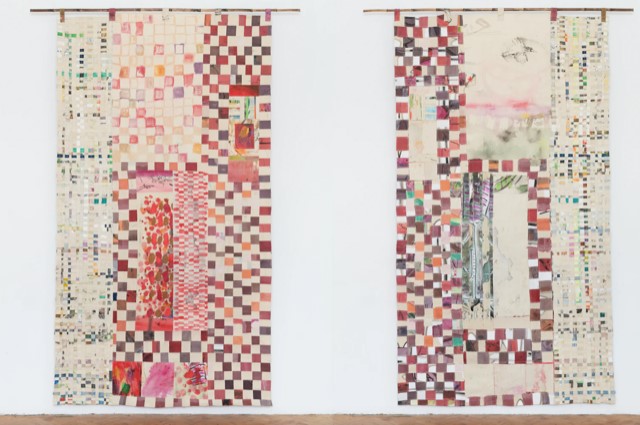
Ben Sanderson, An Exhausted Red, 2023, ink, watercolour, monotype, acrylic, dye, oil, canvas, 155 x 280 cm. Photo: James Banister
Last year, Ben Sanderson was awarded the South West Showcase at Arts University Plymouth. The year-long programme of mentoring and support culminates now with this exhibition at Mirror. Sanderson’s intriguing work is deservedly attracting ever higher levels of attention. Melding a number of techniques, he creates wall-like works that, together, create temporary, intimate spaces all of their own. ‘Walls enclose and divide,’ he observes. His hanging ‘tapestries’ divide rooms like trees or hedges, implying new spaces and proximities, while images and borders within the works themselves instinctively, too, break through the internal edges of the composition.
Lines and details are drawn, sewn, painted and printed with ink, watercolour, acrylic, thread, charcoal and oil onto a support that is not a continuous sheet of paper or canvas but plaited strips created from shredded previous works that have been neatly woven back together by hand.
These carefully-crafted pictures combine a range of effects – decorative, spatial, dynamic and sensual – that spring out of a system of borders within borders. His work varies in size with the largest often hanging from the ceiling with both sides worked upon – a fully-realised ‘front’ and a more accidental ‘back’.
His work echoes his preoccupation with organic growth cycles, with plant-life, gardens and the point where culture attempts to tame nature. Here in response, colour, texture and materials are trained, hybridised, curtailed and let loose. Inspiration comes from the gardens he has visited for years in west Cornwall. His favourite is Penjerrick, justifiably known as the region’s ‘true jungle garden’.
ANNA BARRIBALL: NEW DRAWINGS
Frith Street Gallery 17-18 Golden Square, London W1F 9JJ
2 Feb-14 Mar 2024
https://www.frithstreetgallery.com/exhibitions/224-anna-barriball-new-drawings/
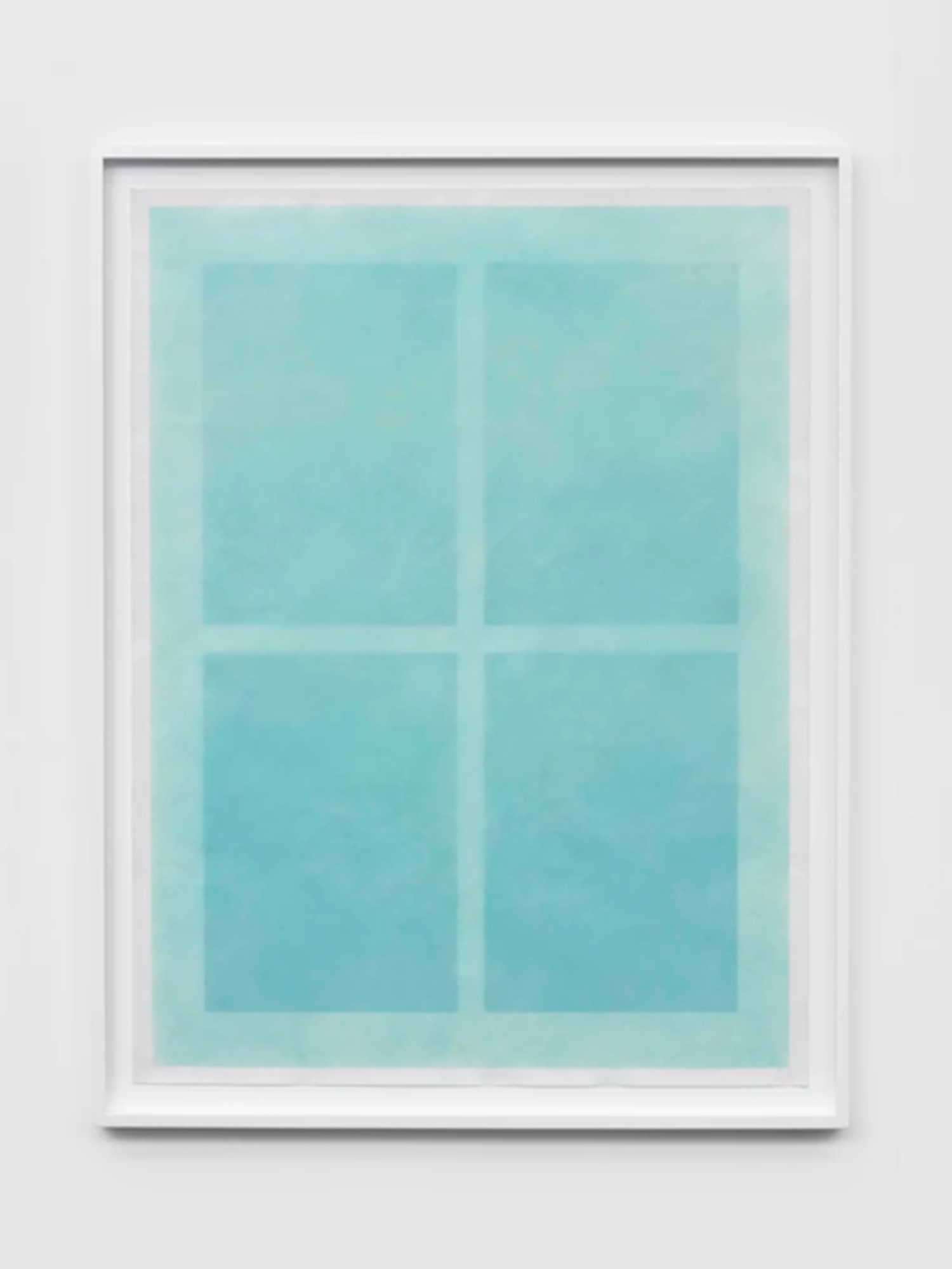
Anna Barriball. Photo courtesy © the artist and Frith Street Gallery, London
In the course of 20 years, Anna Barriball has developed an international career. Her work has a scintillating economy, with her drawings, sculptures and videos evoking sensations linked to memory, particularly feelings and fantasies from childhood and the ever-shifting effect of light upon everyday objects and surroundings.
It is tempting to attribute Barriball’s preoccupation with light to her origins. Although now based in London, she grew up in Cornwall and completed her foundation year at Falmouth College of Art before taking degrees at Winchester and Chelsea. Barriball would not be the first artist to pay homage to the particular qualities of light in Cornwall: its clarity creating distinctive effects in our perception of colour and space.
Yet her work insinuates much more than an ordinary object or a simple play of light. Using a range of media that textures and contextualises – like dusting powdered pastel onto the paper before dipping it into molten wax and folding the new surface horizontally – she both suggests, for example, an image of a window blind, while inviting the viewer into a more elusive story. The experience of looking becomes a journey across subtle nuances of colour and surface that have the ring of familiarity, like those bored hours of childhood when sunny afternoon hours pass too slowly. It is no surprise that Barriball is also one of several artists recently commissioned by Hospital Rooms, the art charity that involves artists in creating therapeutic spaces in Cornwall for service users.
PHILIP GUSTON
Tate Modern 5 October 2023 – 25 February 2024
https://www.tate.org.uk/whats-on/tate-modern/philip-guston
‘They are self-portraits … I perceive myself as being behind the hood … The idea of evil fascinated me … I almost tried to imagine that I was living with the Klan.’ – Philip Guston
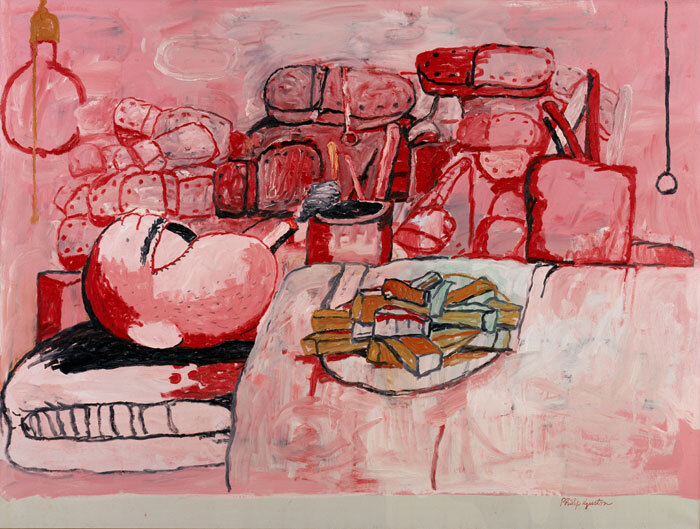
Painting, Smoking, Eating, 1973, by Philip Guston. Photograph: The Estate of Philip Guston, courtesy Tate, Hauser & Wirth
In the 1960s Philip Guston’s work became a by-word for ‘bad painting’. He had made his name in the 1950s with canvases that were abstract but not expressionist. Instead, they were impressionist, very gestural and strangely emptied out. The ‘impressions’ were supplied by viewers who might imagine landscapes, oceans or other such scenes, while knowing they weren’t actually there. There was only colour, brushstrokes, surfaces and edges.
Then Guston began to load all manner of things back into his painting. Most surprisingly, figures returned and critics could not understand why he’d abandoned the mainstream. Perhaps it was the state of the world that did it: the Vietnam War was raging and US cities were burning. His art became caustic and intemperate, mean and raw. And those figures had a cartoon-like quality without being funny. Quite the opposite: one repeating motif included hooded Ku Klux Klan members, riding in cars, smoking cigars, planning and plotting. Their hideous racial crimes were never depicted but Guston’s angry message about social justice got through nonetheless. He frequently created work about racism, antisemitism and fascism.
Born in Montreal in 1913 to a Jewish immigrant family and brought up in Los Angeles, Guston soon developed an interest in social justice and art. In his late teens, he was painting lynchings and Ku Klux Klansmen. His influences were broad and political: Marxism and Mondrian, Piero della Francesca, Max Beckmann, the Mexican muralists (Rivera, Orozco) and eastern spiritualism. He had enduring friendships, too, with modernist composers Morton Feldman and Jackson Pollock.
Guston died in 1980. More than 40 years after his death, his work is still controversial. In 2020, plans for this show were delayed by the four museums, including Tate, that were organising it. Officials feared that these often dark and challenging images would be misunderstood by visitors. It led to protests and resignations. What has changed in three years? The level of common sense at top tables, one hopes. This exhibition, as any by Guston, is unmissable.
KIM LIM: SPACE RHYTHM LIGHT
The Hepworth, Wakefield
25 November 2023 – 2 June 2024
https://hepworthwakefield.org/whats-on/kim-lim/
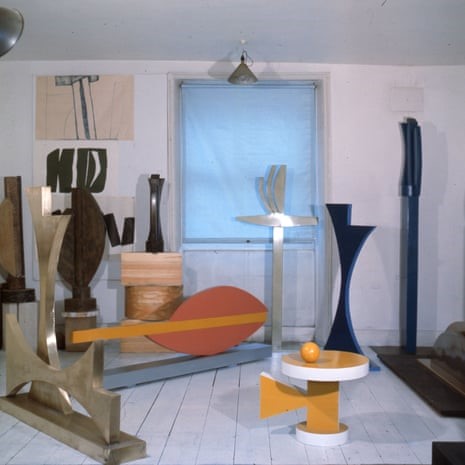
Kim Lim’s undated photograph of her Camden Square studio, c.1960s, featuring the sculptures Twice (1966), Pegasus (1962), Centaur (1963) and Candy (1965). Photo: All Rights Reserved © DACS 2023. Courtesy Kim Lim Estate/Turnbull Studio
The work of British-Singaporean artist Kim Lim has attracted increasing amounts of critical attention since she died in London in 1997. Her work has appeared in numerous group shows highlighting some of the best of post-war British art: in 2021 Tate Britain devoted a room to her sculptures and prints from their collection; a retrospective has just taken place in her native country; and now this show provides the most comprehensive overview of her career since the exhibition at Camden Arts Centre in 1999, planned during her lifetime but which sadly became a memorial celebration.
Lim might be described as an abstract artist at first sight, even a minimalist. Objects with clear profiles from the 60s in fibreglass and metal are colourful and playful. Her carvings in wood, and later in stone, appear simple and reductive. Her inspirations were diverse – music, chess, ancient cultures – but perhaps the most important was nature. Her work echoes the fall of light in rhythmic patterns, and the flow of water. She thought carefully about materials and worked unaided, handling heavy pieces of age-old wood, making bold, powerful forms by stacking and cutting. She carved blocks of marble with chisel and hammer into objects that possess a meditative stillness, smoothing surfaces that she then incised with lines that have affinities with shadows or sinuous grooves made by currents of water.
Allusions emerge of light, pattern, time and breathing. Sculptures made of multiple units had no fixed form but could be rearranged in response to different settings, as if the forms themselves could expand or contract according to the space they were in.
ANDREW CRANSTON: WHAT MADE YOU STOP HERE?
The Hepworth, Wakefield
25 November 2023 – 2 June 2024
https://hepworthwakefield.org/whats-on/andrew-cranston/
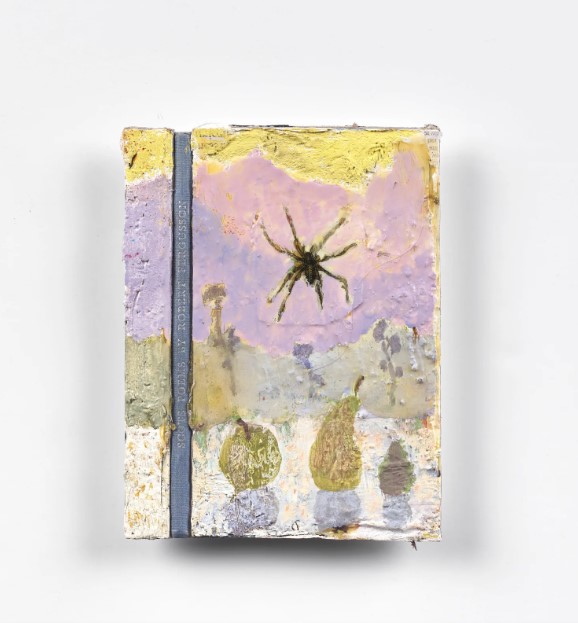
Andrew Cranston, Lies Thick And Still, 2023, oil and varnish on hardback book cover,
19.2 x 14.8 cm. Photo courtesy © the artist and Ingleby Gallery, Edinburgh
‘Feeling as a force, as much as ideas.’ – Andrew Cranston
Andrew Cranston, by his own admission, works slowly. In fact, he wants his viewer to slow down, too. He works on many paintings at the same time, gradually allowing them to take shape over a year or more. His paintings are a record of decisions taken over a long period of leaving and returning, yet which still leave the tantalising sensation, once put out into the public and away from the lengthy studio incubation, of remaining open and unfinished. The small pieces are painted on hardback book covers: collected and stored, then displayed as they are – handled, stained or faded by light. As such, they bring their own history to the studio.
Cranston’s images are figurative and often include animals, and they are intimate in subject matter as well as in scale. Taught by Peter Doig at London’s RCA, the older artist’s influence shows – or it may be evidence of an instant affinity. Cranston draws on a variety of sources, from personal history to the memory of places, anecdotes and jokes. His hero is Giorgio Morandi, who made work of extraordinary order and timelessness during the chaos of mid-century Italy.
EL ANATSUI: BEHIND THE RED MOON (HYUNDAI COMMISSION)
Tate Modern, Until 14 April 2024
https://www.tate.org.uk/whats-on/tate-modern/el-anatsui
EL ANATSUI: TIMESPACE
OCTOBER GALLERY, 24 Old Gloucester Street, Bloomsbury, London WC1N 3AL
11 October 2023 – 13 January 2024
https://octobergallery.co.uk/exhibitions/el-anatsui-timespace
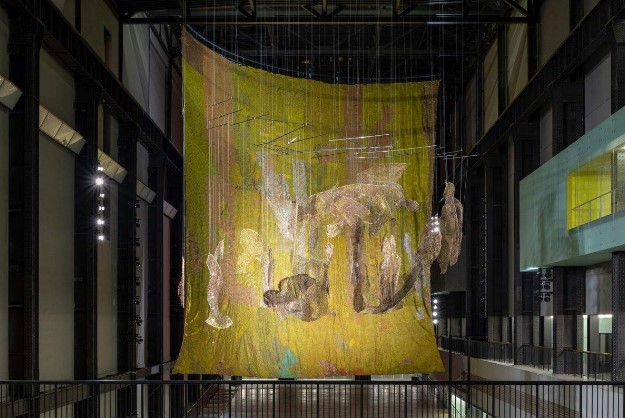
El Anatsui: Behind the Red Moon, 2023, installation view, Tate Modern. Photo © Tate (Joe Humphrys)
The Ghanaian artist El Anatsui established his reputation last century with objects made with clay and tropical hardwoods. For the past 20 years, however, he has been preoccupied with using less illustrious materials, the most striking of all being aluminium bottle tops which, flattened out and linked together with copper wire, are built by an army of assistants into vast metal sheets or drapes; sculptural entities capable of changing shape.
The caps are found everywhere, discarded and thrown away, evidence of the mass-consumption of bottle drinks, many imported to West Africa from abroad. This association with consumption and global trade is especially valued by Anatsui whose work embodies a history of resources in constant movement. Indeed, the work is eminently portable – nomadic, even.
Anatsui’s native country was a hub of the international slave trade, which gives the giant constructions their political and social edge. At the same time, they constitute a combination of African textile aesthetics and global abstraction, with the caps providing glinting surfaces, variegated colour, tessellated texture and repetitive, linear patterns. Each small element is so familiar that it is easily overlooked, yet Anatsui shows this humble ingredient is capable of another function. By being united with others in a hanging curtain large enough to span the Tate’s immense Turbine Hall, the humble bottle top gains presence and power. The show at October Gallery consists of much smaller work, demonstrating the adaptability of Anatsui’s artisanal practice to more intimate settings requiring concentration of form and effect.
MONICA SJÖÖ: THE GREAT COSMIC MOTHER
Modern Art Oxford
8 November - 25 February 2024
https://www.modernartoxford.org.uk/whats-on/monica-sjoo
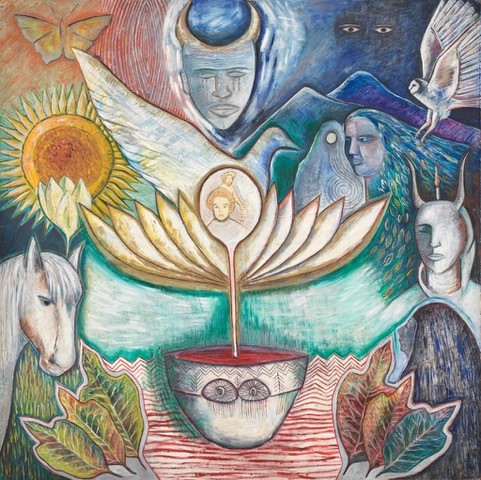
Monica Sjöö, Rebirth from the Motherpot, 1987. Photo courtesy Monica Sjöö Estate and Alison Jacques, London © Monica Sjöö Estate
‘Being a woman has nothing to do with being feminine.’- Monica Sjöö
When the Swedish-born artist, feminist, activist and goddess scholar Monica Sjöö (1938-2005) exhibited her painting God giving birth (1968) at the Guildhall in St Ives in 1971, the police were called to remove it. Depicting a woman of colour straddling the cosmos with a child appearing from her vulva, the powerful image challenged the prevalent patriarchal view of the creative force as male. The local mayor and council went a step further, condemning the work as obscene and blasphemous. The art world did not rush to the artist’s defence. Fifty years later, some attitudes have changed and this show surveys a career into which many forms of making were integrated to create a single, pioneering experience.
Sjöö settled in Britain in the late 1950s and establishing women’s independent voices was the hallmark of her contribution to the second wave of feminism in the 1970s in Europe and America. She saw no separation between gender justice and environmental activism, between writing and painting, banner design and printmaking. This exhibition spans 40 years of her socially-involved art.
Setting out as a painter in the early 60s, she was aware that a visual language did not exist for the imagery she wanted to make. Her work became an exploration of fundamental questions, about forms of expression, about technique as much as figuration. The result was her large-scale, colourful and symbolically intense understanding and communication of the female experience.
Exhibition round up by Martin Holman exclusively for Newlyn School of Art.
Martin Holman is a British art historian and writer on modern and contemporary visual art. He has a special interest in post-war Italian art and has been closely involved with exhibitions in Britain and Italy. His writing has appeared in the exhibition catalogues of public and private galleries, such as Camden Arts Centre, Haunch of Venison, South Bank Centre and Newlyn Art Gallery, and in newspapers and magazines, among them Art Monthly, Art Review, Burlington Magazine, Daily Telegraph, Frieze, The Guardian, Sculpture, The Times Higher Education Supplement and The Tablet. He lives in Penzance.